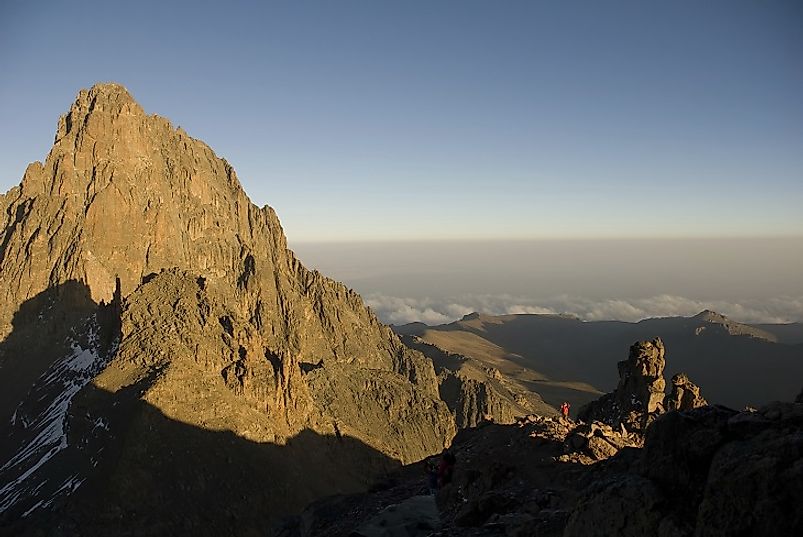Where is Mount Kenya Located?

5. Description
The second highest mountain in Africa after Mt. Kilimanjaro, Mt. Kenya’s highest peak, the Bation, rises to a height of 17,057 feet. The mountain, which is an extinct volcano, is located in central Kenya, 150 kilometers northeast of the capital of the country, Nairobi. The snow-capped mountain is also surprisingly close to the equator located 16.5 kilometers south of the Equator. Lying in the shadow of Mt. Kilimanjaro, Mount Kenya is situated 320 kilometers to the south of this mountain. For its impressive landscape and bewildering biodiversity, Mt. Kenya and its surrounding habitat had been recognized as a UNESCO World Heritage site starting in 1997 onwards. Besides the Bation, Nelion (17,021 feet) and Point Lenana (6,355 feet) are the other notable peaks of Mt. Kenya. Tyndall and Lewis, meanwhile, are the largest among the 12 small, receding glaciers that feed the streams and marshes of the mountain and areas below it.
4. Historical Role
The last volcanic eruption of Mt. Kenya is estimated to have taken place somewhere between 2.6 and 3 million years ago. The stratovolcano probably rose to achieve a height of around 19,700 feet before being eroded down to its current height of 17,057 feet. Prior to the arrival of Europeans in the area, the region around the mountain was inhabited by African indigenous tribes like the Embu people. In 1849, a German missionary worker by the name of Johann Ludwig Krapf became the first European to report the presence of the mountain, as well as the one to assign it the name of Mt. Kenya. Reports from Krapf soon spread like wildfire, and thereafter several attempts were made to climb the mountain. After numerous unsuccessful attempts, in 1899 the British Geographer Halford John Mackinder and his team were the first to a end to the peak of Mt. Kenya.
3. Modern Significance
The fertile soils and water availability on the lower slopes of Mt. Kenya support agricultural practices producing a wide variety of crops. Most prominently, these include the tea, coffee, wheat, barley, rice, bananas, and citrus fruits all being cultivated here. Over 200,000 people inhabit this region, mostly practicing agriculture, cattle ranching, and forestry activities. The forests of the mountain have been heavily exploited by the timber, charcoal, and construction industries for its wood resources. The lure of climbing the snow-capped, tall mountain, coupled with the opportunity to observe its amazing biodiversity and natural splendor, also draws many tourists to this spot every year, increasing the income of the locals of the region from the flourishing tourism industry. The high ecological significance of Mt. Kenya, with its amazing variety of flora and fauna, led the Kenyan National Government in the country to lend a protective status to this ecological region, formally doing so by declaring the formation of the Mt. Kenya National Park in 1949.
2. Habitat
The flora and fauna of Mt. Kenya varies with its different levels of altitude. The dry and warm climate at the base of the mountain supports the growth of grasslands and scrubs. As one moves up, the rich volcanic soil of the lower slopes of the mountain support the growth of high-yield agricultural crops. Vast areas of these slopes, which were previously covered with forests, have now been cleared for the cultivation of food and commercial crops. Human settlements, such as those of the Kikuyu, Embu, and Meru peoples, also are scattered throughout this region of the mountain.
At higher altitudes, Mt. Kenya supports the growth of dense montane forests comprising of trees (East African juniper, Podo, African olives), herbs (clover, balsams, stinging nettles), and shrubs (raspberry, elderberry). These forests also have a natural bamboo zone towards their middle. The drier and cooler climate of the mountain above the montane forest belt allows for the growth of moorlands, with their short, shrub-like vegetation including populations of such plants as African sage, Erica, and sugarbrush species. Further up, Afro-Alpine vegetation exists, which gradually gives way to Alpine desert vegetation, wherein only mosses and lichens are found covering the rocky surfaces. Finally, towards the summit, which is bare and lifeless, ice and snow covered rocks and glaciers form the landscape of Mt. Kenya. A large number of species inhabit the montane forests of Mt. Kenya, including elephants, leopards, hyenas, rhinoceros, the rare albino zebra, and sunni buck, as well a large number of avian species. The latter includes hornbills, parrots, and turacos, while swallows can also be sighted on this mountain. The Afro-Alpine zone also hosts its own set of species including mammals (the African dormice, groove-toothed rat, elands, zebras), birds (alpine chats, Mackinder’s eagle owl, red-tufted sunbirds), butterflies, and wildflowers. The animals in the moorlands, meanwhile, are representative of a mix of the species of the montane forests and Afro-Alpine zones alike
1. Threats and Disputes
As per estimates, nearly 7 million people are dependent upon Mt. Kenya’s water resources for their livelihoods and lifestyles. However, the shrinkage of the mountain’s glaciers, due to a combination of global warming, illegal irrigation practices, extensive cattle grazing on the mountain slopes, and clearance of large tracts of the montane forests, have all lowered the water-holding capacity of the mountain. This is threatening the well-being of the local dwellers of this mountain's adjacent regions. Illegal logging, the expansion of human settlements, the clearance of land for agriculture (including marijuana farming), the poaching of wild species, and increased incidences of forest fires have all led to the destabilization of the Mt. Kenya ecosystem. Such destabilization has pushed many critical species of the region towards the very brink of extinction.











